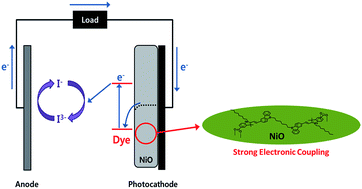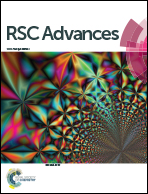Influence of the anchoring number in a carbazole-based photosensitizer on the photovoltaic performance of p-type NiO dye sensitized solar cells†
Abstract
The development of high performance p-type dye sensitized solar cells (DSSCs) is essential for producing tandem configurations that can overcome the theoretical limitations of single-junction DSSCs. This study evaluates a suitable organic dye for producing high performance p-type DSSCs. The photovoltaic properties of the carbazole monomer (MCBZ) and dimer (DCBZ) were examined to determine the effects of the molecular structure of the photosensitizer on the photovoltaic performance. MCBZ absorbs a larger amount of visible light photons with wavelengths between 400 and 600 nm, and provides better p-type DSSCs than conventional coumarin 343-sensitized solar cells. Furthermore, DCBZ exhibits better photovoltaic performance under standard global AM 1.5 solar conditions than the MCBZ-sensitized solar cells because of the synergistic effects of the enhanced electron injection efficiency and reduced charge recombination probability.


 Please wait while we load your content...
Please wait while we load your content...